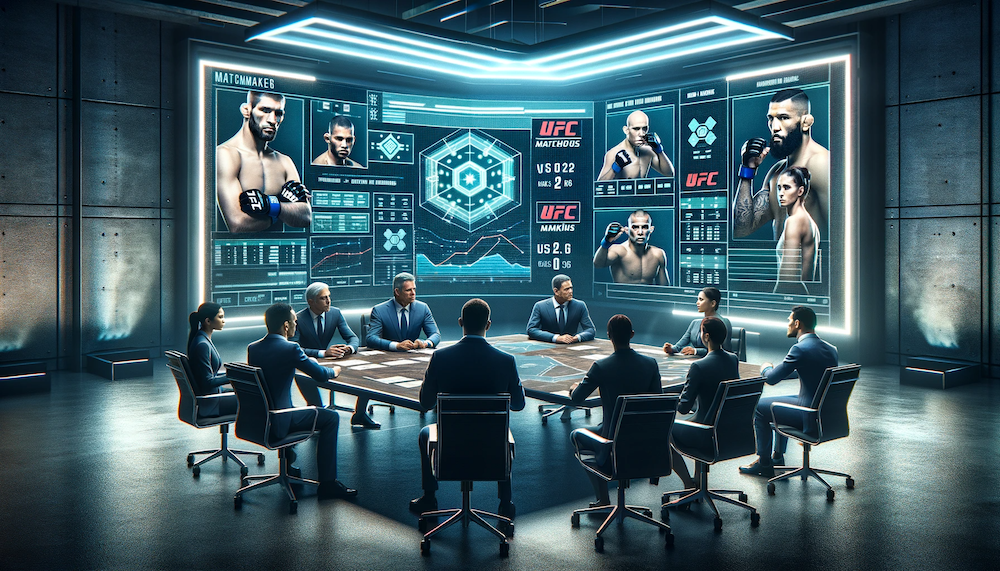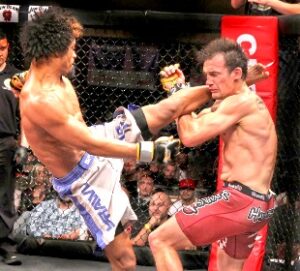
Are you wondering who the UFC matchmakers are?
In this article, we examine who the UFC matchmakers are, what their job entails, and how the process of UFC matchmaking works.
Contents
Who Are the UFC Matchmakers?
As of December 2023, the UFC matchmakers are Sean Shelby, Nick Maynard, and Joe Reeves. While not official UFC matchmakers, Dana White and Hunter Campbell are also involved and often have the final say.
Let’s take a closer look at the 3 current UFC matchmakers.
1. Sean Shelby
Sean Shelby is the UFC matchmaker in charge of 7 UFC weight classes:
- Women’s Strawweight (115 lbs)
- Women’s Flyweight (125 lbs)
- Women’s Bantamweight (135 lbs)
- Bantamweight (135 lbs)
- Featherweight (145 lbs)
- Lightweight (155 lbs)
- Welterweight (170 lbs)
He was also in charge of matchmaking for the UFC women’s featherweight division (145 lbs) until it was scrapped in September 2023.
Sean Shelby was hired by the UFC in 2003 as an executive. He became a UFC matchmaker in 2016, taking on the role of former UFC matchmaker, Joe Silva, who left the promotion.
In September 2016, Sean Shelby was given another position as Senior Vice President of the Talent Relations department.
This role was an extension of his UFC matchmaking, as he would now start developing fighters and scouting for talent globally – thus increasing his ability to be a great UFC matchmaker.
Sean Shelby also takes on pre-UFC event stare-down duties in the absence of Dana White.
Before joining the UFC, Sean Shelby was the WEC matchmaker. WEC was an MMA promotion known for having the best fights in the lower weight class divisions, before the UFC bought them out on December 11, 2006.
His success as the WEC matchmaker is why he continues to matchmake for the UFC’s lower weight class divisions.
Criticism
As good a matchmaker as he is, Sean Shelby received criticism after it was recently revealed by John Kavanagh that he declined Conor McGregor to join the UFC in 2012.
Here’s the email he sent to Conor McGregor’s coach before he became the double champion in Cage Warriors.
2. Mick Maynard
Mick Maynard is the UFC matchmaker in charge of the 4 UFC weight classes:
- Flyweight (125 lbs)
- Middleweight (185 lbs)
- Light heavyweight (205 lbs)
- Heavyweight (205 to 265 lbs)
Before joining the UFC in 2016, Mick Maynard was well-known in the MMA community as the president/owner of the Legacy Fighting Championship (LFC) since 2006, a regional MMA promotion based in Houston, Texas.
He joined the UFC as a matchmaker and Vice President of Talent Relations to help Sean Shelby manage the added workload that appeared after the retirement of former matchmaker, Joe Silva.
Upon joining the UFC, Dana White said about Mick, “Mick has become one of the most respected people in the fight game and he’s done a great job in finding and developing talent”.
Mick Maynard’s most important work since joining the UFC has been to rebuild and grow the flyweight division, which was heading towards extinction before 2020.
Dana White said, “I got to give it to Mick. Mick went in and restructured and rebuilt that division and it’s one of the most exciting divisions in the UFC now.”
3. Joe Reeves
Joe Reeves joined as a UFC matchmaker on Oct. 10, 2023.
His entry into the UFC began as a participant in the “Matchmaker Sweepstakes” competition in 2023, a contest designed for fans to demonstrate their matchmaking skills by creating their ideal fight card.
Joe Reeves emerged as the winner of this competition. His initial prize included a trip to Las Vegas, where he attended a matchmaker meeting and met with UFC President Dana White.
He impressed the UFC’s top brass with his extensive knowledge of the sport and his ability to craft compelling fights, so much so that Dana White offered him a job as a UFC matchmaker and took him to the last episode of the Contender Series.
While speaking at the DWCS press conference, Dana White said of Joe, “I literally just back there, I did all the contracts and I came back in and I said, ‘I got one more. You want to work for the UFC?’ He freaked out. He is a f****** UFC lunatic.
He went toe-to-toe with the boys today, he knew every — bring up a guy on the roster he don’t know. He knows everybody on the roster and he actually did make a fight today.”
Joe Reeves is credited with matchmaking Cody Garbrandt vs. BrianKelleher, booked for UFC 296 in December 2023.
It’s unknown at this time whether Joe Reeves will take charge of matchmaking for a particular weight class.
It’s more likely that he’ll help Sean Shelby and Mick Maynard with general matchmaking, such as pitching potential fights to them in matchmaker meetings.
Why Did Joe Silva Retire as UFC Matchmaker?
Joe Silva retired as UFC matchmaker in 2016 as he made significant profits from the UFC’s sale to WME-IMG for more than $4 billion, and he wanted to spend more time with his family now that he had financial freedom.
This decision ended his remarkable 20-year-long tenure with the UFC, a period during which he played a crucial role in shaping the organization and the sport of mixed martial arts (MMA).
Silva joined the UFC in 1996 when the organization was still emerging and evolving.
His role as a matchmaker was pivotal in the UFC’s transformation from a niche, no-holds-barred event to a globally recognized and regulated sport.
His expertise in matchmaking was not just about pairing fighters; it involved a deep understanding of fighting styles, athlete capabilities, and what makes a compelling and competitive fight.
Silva’s knack for foreseeing exciting matchups made him an invaluable asset to the UFC.
Dana White said of him, “Joe Silva’s contributions to the UFC over the last 20 years were huge, and he played a big role in helping make the sport as big as it is today. He left his mark on this sport and I wish him nothing but success in retirement.”
Joe Silva’s entry into the UFC began with a simple phone call. After seeing an advertisement in Black Belt magazine from Semaphore Entertainment Group looking for fighters, Silva called the number out of interest.
This led to a conversation with Campbell McLaren, who was then running the UFC. Impressed by Silva’s extensive knowledge of martial arts, McLaren encouraged him to start attending UFC events.
Despite initial reluctance, Silva eventually accepted the offer.
This marked the beginning of his 20-year career with the UFC, where he played a pivotal role in shaping the modern MMA rule set and establishing a fundamental methodology for UFC fight booking.
What Do UFC Matchmakers Do?

The primary role of a UFC matchmaker is to create and organize fights, a task that involves a comprehensive set of responsibilities essential to the promotion’s success.
Here’s a closer look at the list of tasks UFC matchmakers have to do:
- Matchmaking: The core task is to arrange fights, pairing fighters in compelling and competitive matchups that align with their skill levels and rankings.
- Analyzing Fighter Abilities: Evaluating fighters’ skills, strengths, and weaknesses to ensure well-matched and fair fights.
- Ranking and Division Considerations: Taking into account fighters’ rankings and the dynamics of each weight division to create logical and exciting matchups.
- Event Planning: Assisting in the planning of UFC events, ensuring a balanced and engaging fight card.
- Negotiations and Communication: Working with fighters and their management teams to negotiate fight agreements.
- Career Development: Guiding fighters through different levels of competition and helping shape their career paths within the UFC. Protecting star-fighters from losses early in their career is important.
- Regulatory Compliance: Ensuring all matchups comply with Athletic Commission regulations and organizational rules. This includes knowing about compulsory medical suspensions.
- Weight Class Division Development and Future Planning: Assessing the viability of existing weight classes, exploring the potential for new weight divisions, and making strategic decisions about the long-term structure of UFC’s weight classes.
- Booking Late Notice Replacements: Finding and booking replacement fighters at short notice when an athlete withdraws from a fight, to ensure the continuity of the event.
In summary, UFC matchmakers are integral to the operation and success of UFC events, balancing the art of fight creation with strategic planning, fighter management, and the ongoing development of the sport’s competitive structure.
How Does UFC Matchmaking Work?
UFC matchmaking is a detailed and strategic process, primarily focused on creating fights that are both exciting for fans and profitable for the organization.
It begins with extensive discussions, pitching, and debating potential matchups during matchmaker meetings in the UFC War Room, involving the matchmakers, UFC President Dana White, and Hunter Campbell.
These initial meetings often held on a Tuesday set the stage for the matchmaking process, where various factors are considered to create compelling and profitable fight cards.
Following these discussions, the process continues with hours of phone calls and emails to fighters, coaches, and lawyers to finalize and sign these matchups.
This collaborative and multi-step approach ensures that each fight is carefully curated to balance fan excitement, fighter merit, and the UFC’s business interests.
Here are 10 things UFC matchmakers have to consider:
- Analyzing Fighter Abilities: Evaluating fighters’ skills, strengths, and weaknesses to ensure well-matched and fair fights.
- Fan Appeal and Market Demand: Understanding what fights fans are eager to see is crucial. This includes gauging fan interest through social media, fan feedback, and media coverage to drive ticket sales and pay-per-view buys.
- Star Power: Fighters with significant fan bases or media attention can draw larger audiences. Their marketability can sometimes lead to them receiving opportunities over more deserving fighters based on performance alone.
- Ranking and Division Considerations: Considering fighters’ rankings and the dynamics of each weight division to create logical and exciting matchups.
- Stylistic Matchups: Considering the style of fighting, such as grappler vs. striker, to create intriguing fights. Sometimes, specific matchups are chosen to manage a fighter’s career path strategically.
- Event Timing and Location: The timing and location of events can influence matchmaking decisions. Certain matchups may be more appealing in specific regions or at particular times of the year, aligning with local interests or global UFC schedules.
- Fighter Health and Availability: Matchmakers must consider fighters’ health, including recovery from injuries and medical suspensions, as well as their availability for training and fight preparation.
- Contractual Obligations: Understanding and managing fighters’ contractual obligations, including fight frequency and exclusivity clauses, is crucial in the matchmaking process.
- Potential Title Implications: For matchups in divisions with a clear title line, matchmakers need to consider how a particular fight might impact the title picture and potential future championship bouts.
- Emergency Contingency Planning: Preparing for last-minute changes due to injuries, weight-cut issues, or other unforeseen circumstances is an essential part of matchmaking. This includes having backup fighters ready or being able to quickly restructure fight cards.
The Bottom Line
In conclusion, the UFC matchmakers, as of December 2023, are Sean Shelby, Mick Maynard, and Joe Reeves, with Dana White and Hunter Campbell also playing significant roles in the decision-making process.
These professionals are tasked with the intricate job of creating and organizing fights, a responsibility that involves a deep understanding of the sport, strategic planning, and a keen sense of what will appeal to fans and drive revenue.
Their role encompasses not just the matchmaking itself but also a range of considerations such as analyzing fighters’ abilities, understanding fan preferences, managing star power, and ensuring regulatory compliance.
The process is collaborative and involves extensive discussions, debates, and negotiations, followed by the practical steps of finalizing and signing matchups.




